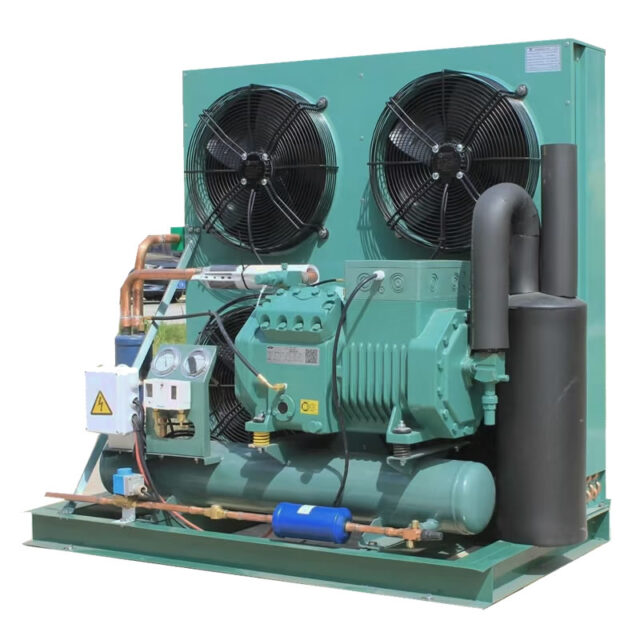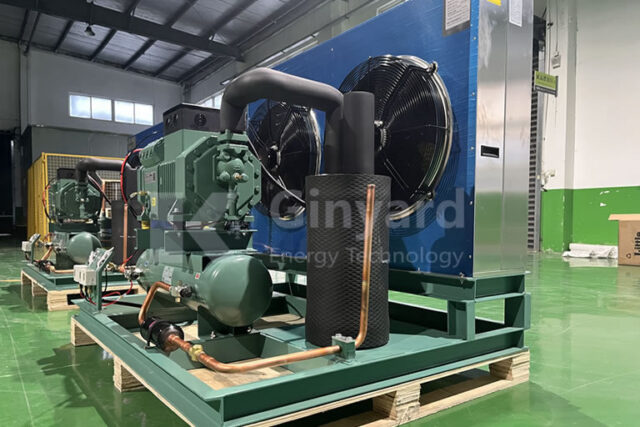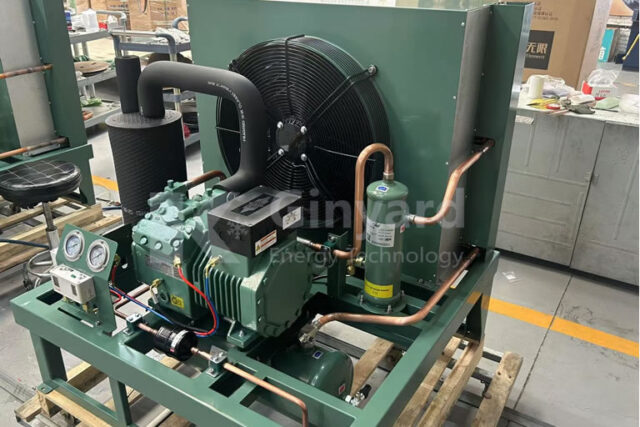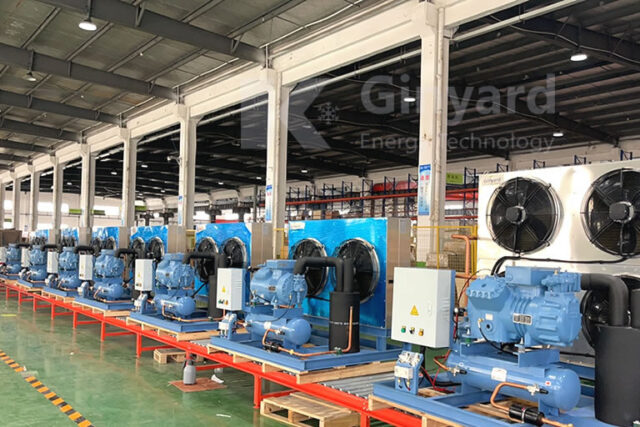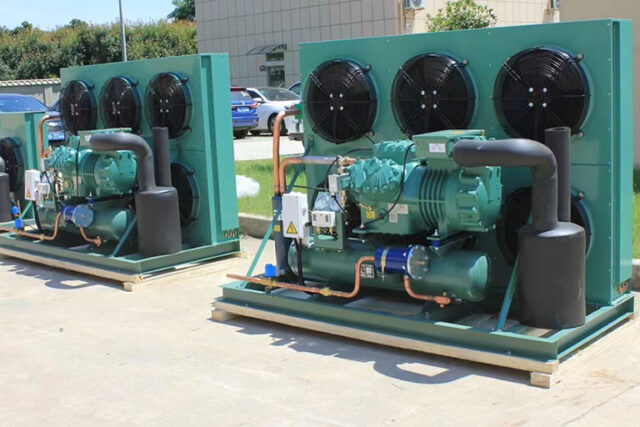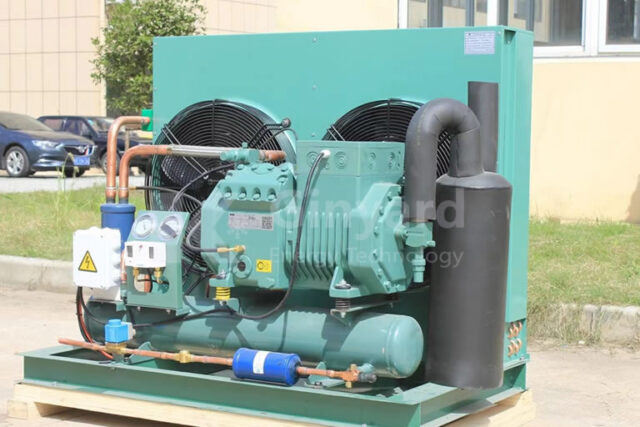- Home
- Condensing Unit
- BITZER Low Temperature Cold Storage Compressor Cold Room Freezer Refrigeration Condensing Unit
BITZER Low Temperature Cold Storage Compressor Cold Room Freezer Refrigeration Condensing Unit
Ginyard refrigeration is a professional manufacturer of condensing units and refrigeration units for commercial refrigeration and transport refrigeration. It is including the refrigerator condensing unit, small condensing unit, monoblock refrigeration unit, indoor condensing unit, outdoor condensing unit, air cooled condensing unit and water-cooled condensing unit, and inverter condensing unit and so on. Customization and OEM are all available..Condensing unit (also called compressor unit) is the most important part of whole cold room system. A condensing unit typically is a high side assembly of a refrigeration system.It is an assembly of compressor, condenser, fan motor, controls and a mounting plate


1. Capacity: This refers to the amount of refrigeration that the unit can provide, typically measured in tons or kilowatts.
2. Compressor Type: Bitzer offers various types of compressors including reciprocating, scroll, and screw compressors.
3. Refrigerant Type: The refrigerant is the substance used to transfer heat in the refrigeration cycle. Bitzer units can be designed to work with a variety of refrigerants, such as R404A, R134a, and R22.
4. Evaporating Temperature: This is the temperature at which the refrigerant evaporates to absorb heat from the surrounding environment. Bitzer units can be designed to operate at different evaporating temperatures depending on the application.
5. Condensing Temperature: This is the temperature at which the refrigerant condenses to release heat to the surrounding environment. Bitzer units can be designed to operate at different condensing temperatures depending on the application.
6. Power Supply: Bitzer Refrigeration Condensing Unit can be designed to operate on various power supplies, such as 220V/50Hz, 380V/50Hz, or 440V/60Hz.
7. Control System: Bitzer Refrigeration Condensing Units may include a control system to monitor and regulate the operation of the unit, including temperature and pressure sensors, as well as control valves and switches.
8. Application: Bitzer Refrigeration Condensing Unit can be designed for different applications, such as air conditioning, refrigeration, or industrial processes. The application will determine the specific parameters required for the unit, such as cooling capacity and operating temperatures.
9. Noise Level: The noise level of a Bitzer Refrigeration Condensing Unit can also be a parameter of interest, as it may be important in certain applications, such as residential or commercial settings.
10. Efficiency: Bitzer Refrigeration Condensing Unit can be designed to operate at different levels of efficiency, which can affect energy consumption and operating costs. Factors that can impact efficiency include the type of compressor, refrigerant, and control system used in the unit.
How to Evaluate the Quality of Open-Type Bitzer Piston Air-Cooled Refrigeration Units?
To determine the quality of open-type Bitzer piston air-cooled refrigeration units, comprehensively assess key indicators such as core performance, structural design, energy efficiency, and reliability. Evaluate based on the following dimensions:
🔧 I. Core Component Performance
Compressor Quality
Verify the use of genuine Bitzer semi-hermetic piston compressors. Inspect designs such as wear-resistant crankshafts, optimized valve groups, and low-friction bearings to ensure longevity and stability.
Energy Adjustment Capability: Units with capacity control heads (e.g., cylinder unloading) or variable frequency drives (VFD) offer superior efficiency under partial loads and enhanced adaptability.
Condenser and Fan Configuration
Prioritize copper-tube aluminum-fin condensers. Check fin-tube expansion quality for uniform fins without damage.
Fans should be low-noise external rotor types. Target operational noise ≤65 dB(A), with sufficient airflow for high-ambient conditions (condensing temperature ≥60°C).
⚙️ II. Operational Efficiency & Cost-Effectiveness
Energy Efficiency Ratio (COP/EER)
Compare labeled COP values. Tier-1 efficiency units save 15%–25% energy long-term versus Tier-3, especially under partial loads.
Cooling Speed Test: Units should reach set temperature within 30 minutes of startup. Delays indicate system mismatches or component defects.
Maintenance Costs
Air-cooled designs eliminate water and cooling tower costs but require evaluating condenser fin cleaning frequency and accessibility.
Inspect brands of standard components (e.g., expansion valves, oil separators). Premium parts reduce failure rates and replacements.
🛠️ III. Reliability & Maintainability
Structural Design Rationality
Open layouts must allow easy access to compressors, oil separators, and key interfaces (e.g., vibration absorbers, junction boxes).
Vibration Damping: Compressor bases should include rubber mounts or spring isolators to prevent pipe resonance and leaks.
Environmental Adaptability
High-temperature performance: Units must maintain rated capacity at 48°C ambient, with discharge pressure within safe limits.
Protection Rating: Electrical cabinets require ≥IP54 rating to resist dust and moisture ingress.
📊 IV. Added Value & Intelligence
Control System
Standard pressure/temperature safeguards (e.g., high/low-pressure controllers, oil differential switches) with remote fault alarms.
Smart models should log energy data for optimization.
Compliance & Sustainability
Verify refrigerant compatibility (e.g., R404A/R507A) and compliance with latest efficiency/noise standards (e.g., GB/T 18430).
🧪 Practical Validation Recommendations
Load Testing: Simulate operational conditions for 72 hours. Monitor temperature stability (±1°C ideal) and start-stop cycles.
Efficiency Comparison: Record power consumption at 100% and 50% loads. Calculate actual COP vs. labeled values (deviation should be <10%).
Noise Testing: Measure sound pressure at 1m distance. Exceeding 75 dB(A) may impact operational environments.
Note: Prioritize suppliers providing traceable compressor serial numbers to confirm genuine Bitzer components. Evaluate lifecycle costs by factoring in spare parts pricing and local service response times.
This translation preserves technical terminology (e.g., “semi-hermetic piston compressors,” “condenser fin cleaning”), measurement units (±1°C, dB(A)), and industry standards (IP54, GB/T 18430) while adapting the structure for international technical documentation clarity.








